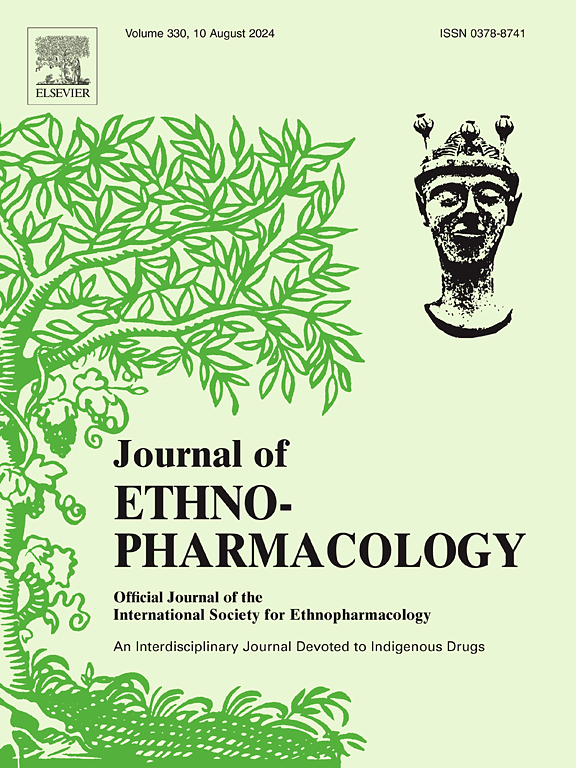结合生物信息学分析、网络药理学、分子对接和实验验证,探索天龙茶抗流感病毒的作用机制
IF 4.8
2区 医学
Q1 CHEMISTRY, MEDICINAL
引用次数: 0
摘要
民族药理学相关性通龙茶(TLC)已被用于呼吸道疾病的临床治疗,如流感,超过三十年。然而,其防御流感的确切机制仍然知之甚少。本研究旨在探讨薄层色谱抗流感病毒的生物活性成分、药理作用及其机制。方法采用超高效液相色谱法(UPLC -Q-Exactive)对薄层色谱中的生物活性成分进行鉴别。利用生物信息学分析、网络药理学、分子对接等方法预测TLC治疗流感的关键治疗靶点和通路。采用细胞病变效应(CPE)抑制试验和斑块减少试验对MDCK细胞进行检测,评价TLC及其主要活性化合物对甲型流感病毒(A/Aichi/2/1968 (H3N2)、A/PR/8/34 (PR8)、A/California/04/2009 (CA04)、A/HK/Y280/97(H9N2)和乙型流感病毒(B/Lee/1940 (Lee))的抗病毒作用。采用H3N2流感病毒感染Balb/c小鼠模型评价TLC的治疗效果。采用定量PCR和Western blot分析,定量测定A549细胞和小鼠肺中TLC潜在机制相关关键靶点的表达水平,探讨h3n2感染后A549细胞中BCL(黄芩苷)的作用机制。建立Jurkat T细胞与h3n2感染的A549细胞共培养模型,通过Western blot分析验证TLC和BCL对关键靶点的调节作用。结果薄层色谱共检出25种活性成分,以BCL为主。TLC和BCL显著抑制上述流感病毒株在MDCK细胞中的复制。此外,TLC降低了h3n2感染小鼠的体重减轻、肺指数、病毒滴度、肺组织病变和促炎细胞因子(IL-1β、IL-6、IL-8、IP-10、TNF-α)、干扰素(IFN-γ)和趋化因子(MCP-1)的水平。机制研究表明,TLC和BCL上调白细胞间素(IL)-2诱导的T细胞激酶(ITK)和酪氨酸蛋白激酶(FYN)的表达,下调丝裂原活化蛋白激酶(MAPK14)的表达,从而调节T细胞受体信号通路,生物信息学分析、网络药理学和分子对接预测。结论薄层色谱可通过调节T细胞受体信号通路抑制流感病毒复制,减轻过度炎症反应,提示薄层色谱可能是一种有前景的中药治疗流感的药物。本文章由计算机程序翻译,如有差异,请以英文原文为准。

Integrating bioinformatic analysis, network pharmacology, molecular docking and experimental validation to explore the mechanism of Tian Long Cha against influenza virus
Ethnopharmacological relevance
Tong Long Cha (TLC) has been employed in clinical treatment for respiratory diseases, such as influenza, for over three decades. However, the precise mechanisms underlying its defense against influenza remain poorly understood.
Aim of study
This study aimed to investigate the bioactive compounds, pharmacological effects, and underlying mechanisms of TLC in combating influenza viruses.
Methods
Ultrahigh-performance liquid chromatography (UPLC)-Q-Exactive analysis was employed to identify the bioactive compounds of TLC. Key therapeutic targets and pathways involved in TLC's treatment for influenza were predicted using bioinformatics analysis, network pharmacology, and molecular docking. The antiviral effects of TLC and its principal active compound against various strains of influenza A viruses (A/Aichi/2/1968 (H3N2), A/PR/8/34 (PR8), A/California/04/2009 (CA04), A/HK/Y280/97(H9N2)) and influenza B virus (B/Lee/1940 (Lee)) were assessed using the cytopathic effect (CPE) inhibition assay and plaque reduction assay in MDCK cells. The therapeutic effects of TLC were evaluated using an influenza H3N2 virus-infected Balb/c mouse model. Quantitative PCR and Western blot analyses were employed to quantify the expression levels of key targets involved in TLC's potential mechanisms within A549 cells and the lungs of mice, as well as to investigate BCL's (baicalin) mechanism in A549 cells post-H3N2 infection. A co-culture model using Jurkat T cells and H3N2-infected A549 cells was also established to verify the modulation of key targets by TLC and BCL by using Western blot analyses.
Results
A total of 25 bioactive compounds were identified in TLC, with BCL being the predominant compound. TLC and BCL significantly inhibited the replication of the aforementioned influenza virus strains in MDCK cells. Additionally, TLC reduced weight loss, lung index, viral titers, lung tissue lesions, and levels of pro-inflammatory cytokines (IL-1β, IL-6, IL-8, IP-10, TNF-α), interferon (IFN-γ), and chemokine (MCP-1) in H3N2-infected mice. Mechanistic studies revealed that TLC and BCL upregulated Interleukin (IL)-2-inducible T cell kinase (ITK) and Tyrosine-protein kinase (FYN) expression while downregulating mitogen-activated protein kinase (MAPK14) expression, thereby modulating the T cell receptor signaling pathway, as predicted by bioinformatics analysis, network pharmacology, and molecular docking.
Conclusion
TLC could inhibit influenza virus replication and mitigate excessive inflammatory responses by modulating the T cell receptor signaling pathway, suggesting that it may serve as a promising therapeutic agent in traditional Chinese medicine for the treatment of influenza.
求助全文
通过发布文献求助,成功后即可免费获取论文全文。
去求助
来源期刊

Journal of ethnopharmacology
医学-全科医学与补充医学
CiteScore
10.30
自引率
5.60%
发文量
967
审稿时长
77 days
期刊介绍:
The Journal of Ethnopharmacology is dedicated to the exchange of information and understandings about people''s use of plants, fungi, animals, microorganisms and minerals and their biological and pharmacological effects based on the principles established through international conventions. Early people confronted with illness and disease, discovered a wealth of useful therapeutic agents in the plant and animal kingdoms. The empirical knowledge of these medicinal substances and their toxic potential was passed on by oral tradition and sometimes recorded in herbals and other texts on materia medica. Many valuable drugs of today (e.g., atropine, ephedrine, tubocurarine, digoxin, reserpine) came into use through the study of indigenous remedies. Chemists continue to use plant-derived drugs (e.g., morphine, taxol, physostigmine, quinidine, emetine) as prototypes in their attempts to develop more effective and less toxic medicinals.
 求助内容:
求助内容: 应助结果提醒方式:
应助结果提醒方式:


